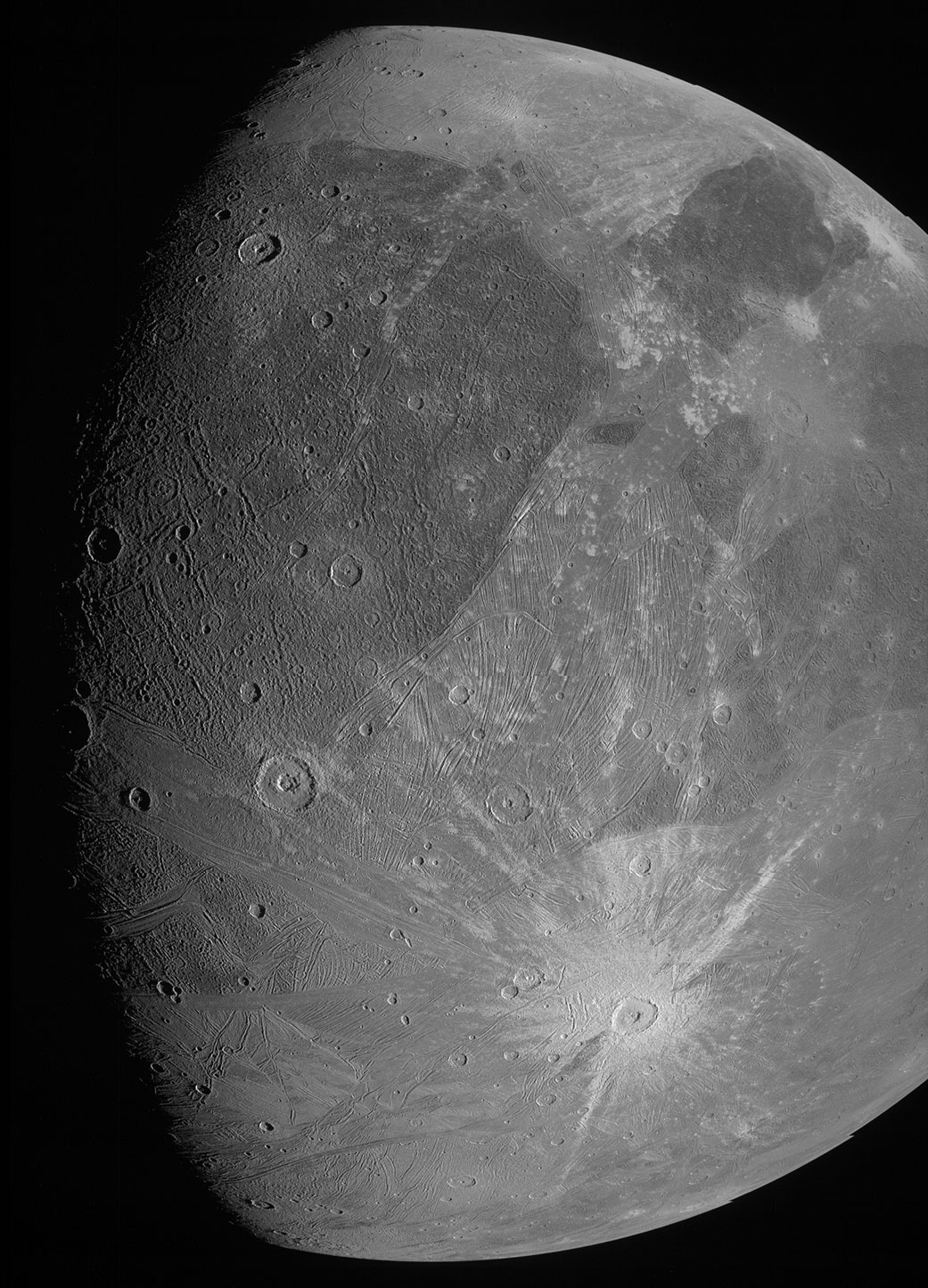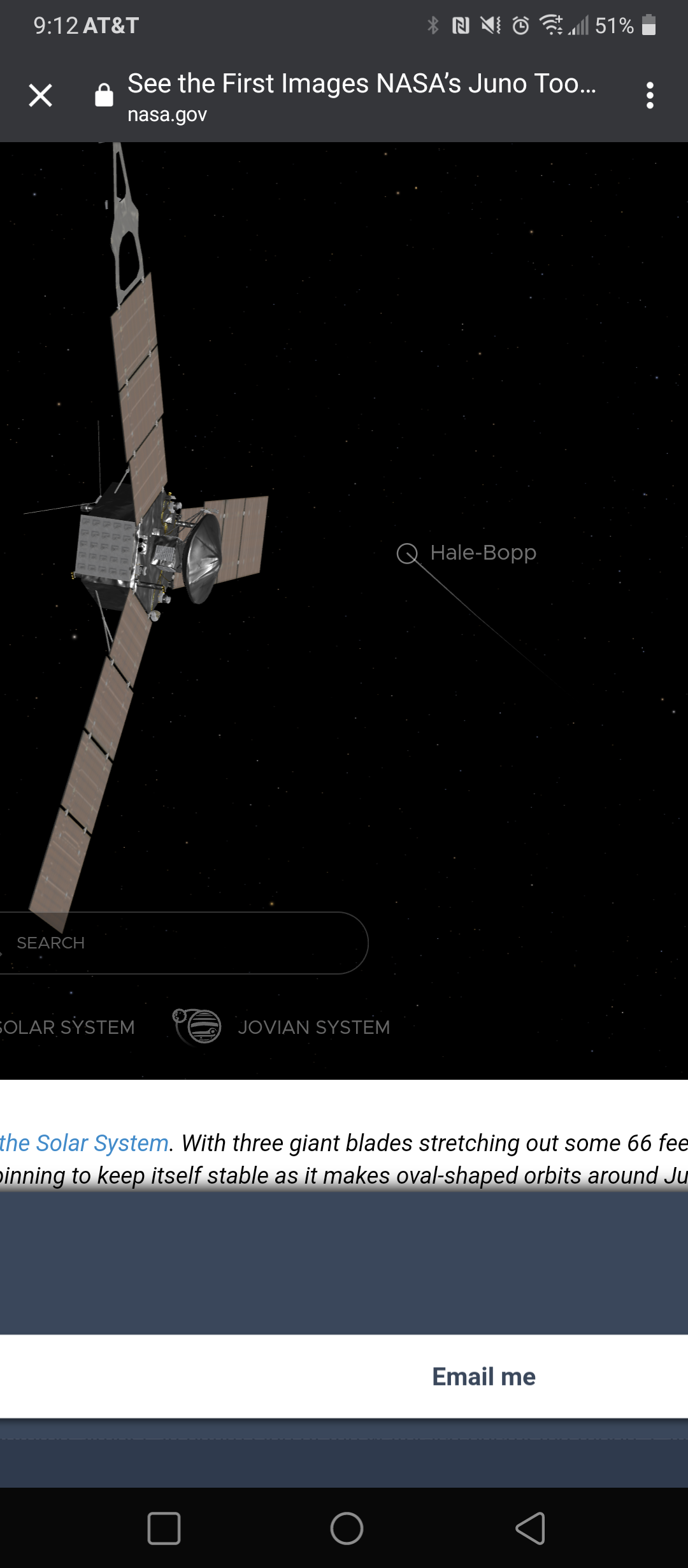It looks like you're using an Ad Blocker.
Please white-list or disable AboveTopSecret.com in your ad-blocking tool.
Thank you.
Some features of ATS will be disabled while you continue to use an ad-blocker.
24
share:
Ganymede is Jupiter's largest and most massive Moon , in fact it's the largest and most massive Moon in our Solar System , it has a diameter of about
half that of Earth and is the only Moon known to have a magnetic field plus it's believed to have more water than Earth ... except on Ganymede it's
water is locked beneath an icy shell.
This new image was captured on June 7, 2021.

It also make a nice desktop background.
This new image was captured on June 7, 2021.

“This is the closest any spacecraft has come to this mammoth moon in a generation,” said Juno Principal Investigator Scott Bolton of the Southwest Research Institute in San Antonio. “We are going to take our time before we draw any scientific conclusions, but until then we can simply marvel at this celestial wonder.”
Using its green filter, the spacecraft’s JunoCam visible-light imager captured almost an entire side of the water-ice-encrusted moon. Later, when versions of the same image come down incorporating the camera’s red and blue filters, imaging experts will be able to provide a color portrait of Ganymede. Image resolution is about 0.6 miles (1 kilometer) per pixel.
In addition, Juno’s Stellar Reference Unit, a navigation camera that keeps the spacecraft on course, provided a black-and-white picture of Ganymede’s dark side (the side opposite the Sun) bathed in dim light scattered off Jupiter. Image resolution is between 0.37 to 0.56 miles (600 to 900 meters) per pixel.
“The conditions in which we collected the dark side image of Ganymede were ideal for a low-light camera like our Stellar Reference Unit,” said Heidi Becker, Juno’s radiation monitoring lead at JPL. “So this is a different part of the surface than seen by JunoCam in direct sunlight. It will be fun to see what the two teams can piece together.”
www.nasa.gov...
It also make a nice desktop background.
edit on 9-6-2021 by gortex because: (no reason given)
a reply to: FinallyAwake
I guess some of them are frozen over cracks as a result of the stresses and strains of its orbit of Jupiter.
Lots of strange lines when zoomed in, but i guess that would be the frozen water crust?
I guess some of them are frozen over cracks as a result of the stresses and strains of its orbit of Jupiter.
A lot of contrast in the surface material.
Interesting.
I wonder if the difference is just ice presence.
Interesting.
I wonder if the difference is just ice presence.
my guess is that the infant moon kept collecting ice crystals as comets fell onto the gravity well
liquid water existed in secomds/minutes after the impacts, then eons of ice build up allowed the deep layers of ice to get squeezed by the mother planets' gravitational forces' ... and eventually a deep pool of liquid water exists, water ice from the oort cloud no doubt
yum
liquid water existed in secomds/minutes after the impacts, then eons of ice build up allowed the deep layers of ice to get squeezed by the mother planets' gravitational forces' ... and eventually a deep pool of liquid water exists, water ice from the oort cloud no doubt
yum
The darker spots must be the oldest surface; being covered in dust making the ice look darker.
It is also where there seems to be more features of compression and wavy lines and also showing the most meteoric impacts with lots being partially refilled.
The paler regions look very smooth in long stretches or with long straight lines.
It is also where there seems to be more features of compression and wavy lines and also showing the most meteoric impacts with lots being partially refilled.
The paler regions look very smooth in long stretches or with long straight lines.
I found Hale-Bopp on the interactive part on that NASA link. It'll be the year 4385 before Earth sees it again.


edit on 9-6-2021 by LSU2018 because: (no reason given)
new topics
-
This is adorable you guys!
General Chit Chat: 6 hours ago -
Reprehensible Behavior
US Political Madness: 7 hours ago -
Defending the need for adherence to Old Testament commandments under the new covenant of Christ
Conspiracies in Religions: 8 hours ago
top topics
-
Reprehensible Behavior
US Political Madness: 7 hours ago, 10 flags -
Those Drones over NJ and elsewhere
Aliens and UFOs: 12 hours ago, 8 flags -
South Korean coup was an attempt to start WW3
World War Three: 13 hours ago, 7 flags -
This is adorable you guys!
General Chit Chat: 6 hours ago, 7 flags -
Archer aviation and the NJ drones
Aircraft Projects: 13 hours ago, 5 flags -
Defending the need for adherence to Old Testament commandments under the new covenant of Christ
Conspiracies in Religions: 8 hours ago, 5 flags
active topics
-
The Mystery Drones and Government Lies --- Master Thread
Political Conspiracies • 104 • : DaydreamerX -
Defending the need for adherence to Old Testament commandments under the new covenant of Christ
Conspiracies in Religions • 11 • : randomuser2034 -
Drones everywhere in New Jersey ---and Elsewhere Master Thread
Aliens and UFOs • 171 • : nugget1 -
Post A Funny (T&C Friendly) Pic Part IV: The LOL awakens!
General Chit Chat • 7912 • : imitator -
This is adorable you guys!
General Chit Chat • 4 • : CriticalStinker -
The Acronym Game .. Pt.4
General Chit Chat • 1016 • : FullHeathen -
Could rampant land speculation have caused the Civil War?
History • 35 • : matafuchs -
George Stephanopoulos and ABC agree to pay $15 million to settle Trump defamation suit
Mainstream News • 23 • : Brotherman -
Pelosi injured in Luxembourg
Other Current Events • 45 • : rickymouse -
Nov 2024 - Former President Barack Hussein Obama Has Lost His Aura.
US Political Madness • 19 • : Connector
24
